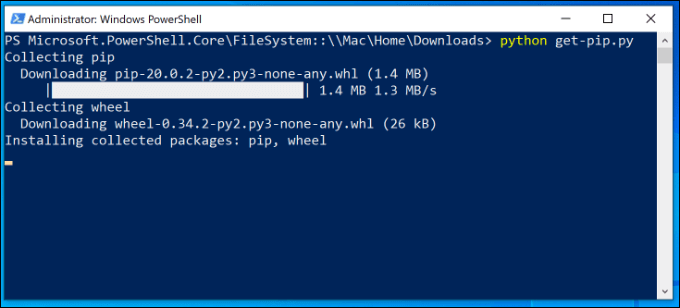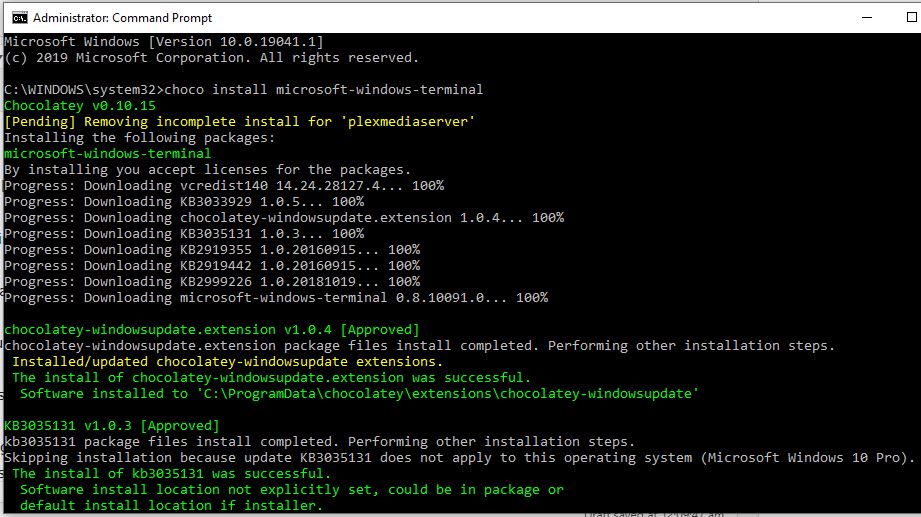
Select Interaction to determine the formats for copying and pasting.Select Startup to control how a terminal window looks and acts when you open it.Select a specific category, make the changes you want, and then click Save to save them or Discard changes to reject them ( Figure G).įigure G Choose your settings on startup. Click the down arrow and select Settings to open another tab with various categories for settings.
#Install windows terminal command line windows
Scroll down the window and select the command you want to run ( Figure F).įigure F Choose the Windows Command Pallette.įinally, you can customize the look and behavior for Windows Terminal. From the same menu, select Command Palette. To make sure you enter the right commands and syntax, you can select a command from a list.

You can choose a Windows PowerShell window, a traditional Command Prompt window, or an Azure Cloud Shell window ( Figure E).įigure E Choose what type of tab you want open Click the down arrow next to the + button. Next, you can choose what type of window to open. Click X to close a specific tab ( Figure D). You can then move the order of the tabs by dragging and dropping one to the left or right. To work with additional command prompt windows, click the + button for each tab you wish to open. Windows Terminal opens with a PowerShell prompt, so you can use this for PowerShell scripts or as a standard command prompt ( Figure C).įigure C This opens up a Windows PowerShell script. If you need to open it as an administrator, right-click the shortcut, move to the More menu, and select Run as administrator ( Figure A).įigure A Run Windows as an administrator.Īlternatively, click the Search icon, start typing Windows Terminal, and then select Open or Run as Administrator from the search results ( Figure B).įigure B Another way is to start typing Windows Terminal, and then select Open or Run as Administrator. Scroll down the Start menu and select the shortcut for Windows Terminal. To open Windows Terminal in Windows 11, click the Start button and select All Apps. SEE: Windows 11: Tips on installation, security and more (free PDF) (TechRepublic) You can launch multiple tabs with different windows, choose whether to open a traditional command prompt or a PowerShell window, and customize the look and functionality of the terminal window. Designed to launch a PowerShell command prompt, Windows Terminal offers a few enhancements over the traditional command prompt. Windows 11 comes with a command line tool dubbed Windows Terminal. Image: Julia Tim/Adobe Stock Must-read Windows coverageĭefend your network with Microsoft outside-in security services Windows Terminal offers some improvements over the standard command prompt window. You might also be interested in PEP-397.How to use Windows Terminal in Windows 11 If you have installed multiple versions of Python (which isn't all that uncommon) you might be better off not putting any of them on the PATH but instead create different shortcuts to cmd.exe for the different versions which set the PATH for each version.
#Install windows terminal command line install
The Scripts subdirectory is not present after a clean install of Python, but will be created when needed.)ĭon't put any additional Lib or DLL directory on the PATH. This is about as UNIX-y as it gets for Windows. This will allow you to run scripts like easy_install, pip, virtualenv or sphinx from the command line - once you install those, that is. Or, to put it in other words (and using the previous example): add C:\Python27 C:\Python27\Scripts. When modifying the PATH, also add the Scripts subdirectory. This means you have to re-launch cmd.exe for the changes to work. Modifying environment variables (including PATH) from the "Edit System Variables" has no effect on already running processes. Setting it to C:\Python27\ will not accomplish anything useful, although it's probably harmless. The PYTHONPATH environment variable tells Python where to look for modules to import. %USERPROFILE%\AppData\Local\Programs\Python\Python36ĭon't set PYTHONPATH if all you want is to get Python on the PATH. If you wish you can add to your path environment variable:

When I am at C:\Users\sg7> directory level python can be invoked by typingĪppData\Local\Programs\Python\Python36\python C:\Users\samg>AppData\Local\Programs\Python\Python36\pythonĬ:\Users\YourUserNameHere\AppData\Local\Programs\Python\Python37 Please be aware that in my case Python was installed in C:\Users\sg7\AppData\Local\Programs\Python\Python36> directory C:\Users\sg7\AppData\Local\Programs\Python\Python36>dirĭirectory of C:\Users\sg7\AppData\Local\Programs\Python\Python36 Type "help", "copyright", "credits" or "license" for more information. Just typing py in the Command Prompt Window starts Python. I have installed the latest Python for Win10 from Releases for Windows.


 0 kommentar(er)
0 kommentar(er)
